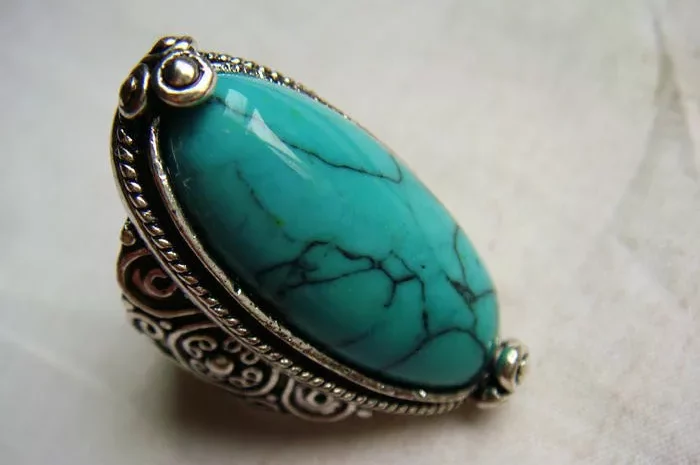Turquoise is a beautiful and captivating gemstone known for its unique blue-green color and distinct veining patterns. As one of the oldest gemstones in human history, turquoise has been prized for its beauty and spiritual significance for thousands of years. However, due to its popularity, there are many imitations and synthetics on the market, making it essential to know what real turquoise looks like. In this article, we’ll explore the characteristics of real turquoise and how to distinguish it from fake or treated versions.
Introduction to Turquoise
Turquoise is a hydrated phosphate mineral that forms in the cracks and crevices of rocks through a process known as secondary mineralization. It is typically found in arid regions where groundwater carrying minerals such as copper and aluminum seeps through the rock, creating the conditions necessary for turquoise formation. The presence of copper is what gives turquoise its distinctive blue color, while the presence of iron can create greenish tones.
Turquoise has been prized by cultures around the world for its beauty and spiritual significance. In many Native American cultures, turquoise is considered a sacred stone that symbolizes protection, wisdom, and abundance. The ancient Egyptians, Persians, and Aztecs also revered turquoise for its beauty and believed it had healing and protective properties.
What Does Real Turquoise Look Like?
Real turquoise exhibits several characteristics that distinguish it from imitations and synthetics. These characteristics can help you determine whether a piece of turquoise is genuine:
Color: The most important characteristic of real turquoise is its color. Genuine turquoise can range from a light sky blue to a deep, vibrant blue-green. The color should be uniform throughout the stone, with no noticeable variations or patches of different colors. Greenish tones are also common in turquoise, especially in stones with a higher iron content. However, the color should never be too dark or too bright, as this may indicate the presence of dyes or treatments.
Matrix: Turquoise often contains matrix, which is the host rock or other minerals that are intergrown with the turquoise. The matrix can vary in color and appearance, ranging from black to brown to golden-brown. The matrix adds to the unique beauty of turquoise and is often used to identify the origin of the stone. However, the matrix should be natural and not artificially added or enhanced.
Veining: One of the most distinctive features of turquoise is its veining patterns, which are caused by the presence of other minerals such as pyrite or limonite. These veins can vary in color and intensity, ranging from thin, delicate lines to bold, striking patterns. The veining should be natural and not too uniform or symmetrical, as this may indicate that the stone has been artificially enhanced.
Hardness: Turquoise has a hardness of 5 to 6 on the Mohs scale, making it relatively soft compared to other gemstones. This means that turquoise can be easily scratched or damaged if not handled with care. Genuine turquoise should not scratch easily, but it can be scratched by harder materials such as quartz or topaz.
Luster: Real turquoise has a waxy to subvitreous luster, meaning that it should have a somewhat glossy appearance. However, the luster should not be too shiny or glassy, as this may indicate that the stone has been treated or enhanced.
Transparency: Turquoise is typically opaque, meaning that it does not allow light to pass through it. However, some high-quality turquoise may exhibit a slight translucency, especially in thinner pieces. This translucency should be natural and not the result of treatments or enhancements.
How to Identify Fake Turquoise
There are several ways to identify fake turquoise:
Color: Fake turquoise may have a uniform, unnatural color that is too bright or too dark. It may also exhibit a lack of variation or veining patterns.
Matrix: Fake turquoise may have a matrix that looks artificial or is too uniform in color and appearance. The matrix may also be too perfect or symmetrical.
Hardness: Fake turquoise may be harder than genuine turquoise and may not scratch as easily.
Luster: Fake turquoise may have a shiny, glassy luster that is not typical of real turquoise.
Transparency: Fake turquoise may be more transparent than genuine turquoise, allowing light to pass through it more easily.
Price: Be wary of turquoise that is priced significantly lower than market value, as this may indicate that the stone is not genuine.
Conclusion
In conclusion, real turquoise exhibits a unique combination of color, matrix, veining, hardness, luster, and transparency that distinguishes it from imitations and synthetics. By familiarizing yourself with the characteristics of real turquoise and knowing what to look for, you can confidently identify genuine turquoise and avoid being misled by fake or treated stones. Whether you’re purchasing turquoise for its beauty, spiritual significance, or cultural heritage, knowing how to distinguish real turquoise from fake will ensure that you’re getting a genuine and authentic gemstone.


